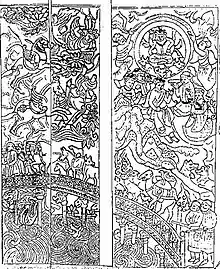Chinvat Bridge
The Chinvat Bridge [ʧinva:t] (Avestan: 𐬗𐬌𐬥𐬬𐬀𐬙𐬋 𐬞𐬈𐬭𐬈𐬙𐬏𐬨 Cinvatô Peretûm, "bridge of judgement" or "beam-shaped bridge")[1] or the Bridge of the Requiter[2] in Zoroastrianism is the sifting bridge,[3] which separates the world of the living from the world of the dead. All souls must cross the bridge upon death. The bridge is guarded by two four-eyed dogs, described in the Videvdat (Vendidad) 13,9 as 'spâna pəšu.pâna' ("two bridge-guarding dogs").[4][5] A related myth is that of Yama, the Hindu ruler of Hell who watches the gates of Hell with his two four-eyed dogs.
| Part of a series on |
| Zoroastrianism |
|---|
 |
|
|
The Bridge's appearance varies depending on the observer's asha, or righteousness. As related in the text known as the Bundahishn, if a person has been wicked, the bridge will appear narrow and the demon Chinnaphapast will emerge[6] and drag their soul into the druj-demana (the House of Lies), a place of eternal punishment and suffering similar to the concept of Hell.[7] If a person's good thoughts, words and deeds in life are many, the bridge will be wide enough to cross, and the Daena, a spirit representing revelation, will appear and lead the soul into the House of Song. Those souls that successfully cross the bridge are united with Ahura Mazda. Often, the Chinvat Bridge is identified with the rainbow, or with the Milky Way galaxy, such as in Professor C.P. Tiele's "History of Religion ".[8] However, other scholars such as C.F. Keary and Ferdinand Justi disagree with this interpretation, citing descriptions of the Chinvat Bridge as straight upward, rather than curvilinear.[9][10]
Three divinities are thought to be guardians of the Chinvat Bridge: Sraosha (Conscience), Mithra (Covenant) and Rashnu (Justice).[7]
Alternate names for this bridge include Chinwad, Cinvat, Chinvar or Chinavat.[11]
The concept of the Chinvat bridge is similar to that of the As-Sirāt in Islam.
In scripture
In the 71st chapter of the Avestan text, the Yasna, there is a description of the Chinvat Bridge.
|
|
The Vendidad also describes the Chinvat Bridge in fargard 19.
|
|
In literature
Dimitris Lyacos's second part of the trilogy Poena Damni With the People from the Bridge alludes to the Chinvat Bridge. In the book a bridge functions as part of the setting of a makeshift performance but also as a narrative element that connects the world of the living with the world of the dead.[15]
American poet Charles Olson references the Chinvat Bridge ("Cinvat" in his reading) in his epic, The Maximus Poems; a work which deals with Avestan mythology, among numerous others.
In visual culture

Representations of bridges on early medieval Sogdian funerary couches have been identified as the Chinvat Bridge. The most notable of these appears on the east wall of the funerary couch of the sabao Wirkak excavated at Xi'an,[16][17] but another fragmentary depiction appears on the funerary couch in the Miho Museum.[18]
See also
- As-Sirāt
- Bifröst
- Brig of Dread
- Vaitarna River
- Otherworld
- Zoroastrian eschatology
References
- "Paradise Found: Part Fourth: Chapter V. The Cradle of the Race in Iranian, or Old-Persian, Thought".
- Merriam-Webster, Inc. (1999). Doniger, W. (ed.). Merriam-Webster's Encyclopedia of World Religions. Merriam-Webster. p. 421. ISBN 9780877790440.
- Dawson, M. M. (2005). The Ethical Religion of Zoroaster. Kessinger Publishing. p. 237. ISBN 9780766191365.
- Dirven, Lucinda. "My Lord with his Dogs. Continuity and Change in the Cult of Nergal in Parthian Mesopotamia". In: Edessa in hellenistisch-römischer Zeit: Religion, Kultur und Politik zwischen Ost und West. Beiträge des internationalen Edessa-Symposiums in Halle an der Saale, 14–17. Juli 2005, eds. Lutz Greisiger, Claudia Rammelt and Jürgen Tubach. Beiruter Texte und Studien 116. Beirut/Würzburg: Ergon Verlag. 2009. pp. 66-67 (also footnote nr. 95). ISBN 978-3-89913-681-4
- Foltz, Richard. "Zoroastrian Attitudes toward Animals". In: Society and Animals 18 (2010). Leiden, the Netherlands: Brill. 2010. p. 371.
- "The Bundahishn ("Creation"), or Knowledge from the Zand: chapters 24-28".
- Eduljee, Ed. "Page 1. Zoroastrianism After Life. Zoroastrian Funeral Customs & Death Ceremonies".
- Tiele, C.P. History of Religion. London and Boston, 1877: p. 177.
- C. F. Keary, Primitive Belief. Lond., 1882: p. 292.
- Rawlinson, The Seven Great Monarchies of the Ancient Eastern World: Parthia and Sassania. Gorgias Press LLC, 2002. ISBN 1-931956-47-2
- "Glossary of Zoroastrian terms".
- "AVESTA: YASNA (English): Chapters 54-72".
- "Archived copy". Archived from the original on 2009-02-25. Retrieved 2009-01-17.CS1 maint: archived copy as title (link)
- "AVESTA: VENDIDAD (English): Fargard 19".
- "Exercise Bowler Issue 21".
- Lerner, Judith A. "Les Sogdiens En Chine—Nouvelles Découvertes Historiques, Archéologiques Et Linguistiques and Two Recently Discovered Sogdian Tombs in Xi'an". Bulletin of the Asia Institute, New Series, 15 (2001): 151-62. JSTOR 24049043. Missing or empty
|url=(help) - ""Les Sogdiens en Chine--Nouvelles découvertes historiques, archéologiques et linguistiques" and Two Recently Discovered Sogdian Tombs in Xi'an".
- Grenet, Frantz. "Mary Boyce's Legacy for the Archaeologists." Bulletin of the Asia Institute, New Series, 22 (2008): 29-46 (illustrated on page 42). https://www.jstor.org/stable/24049233.